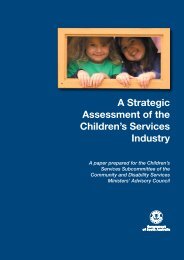Global Study On Child Poverty And Disparities (PDF) - Social Policy ...
Global Study On Child Poverty And Disparities (PDF) - Social Policy ...
Global Study On Child Poverty And Disparities (PDF) - Social Policy ...
Create successful ePaper yourself
Turn your PDF publications into a flip-book with our unique Google optimized e-Paper software.
GLOBAL STUDY<br />
ON CHILD<br />
POVERTY &<br />
DISPARITIES<br />
The Pillars of<br />
<strong>Child</strong> Well-being<br />
This section discusses the ‘pillars’<br />
of well-being for children: nutrition,<br />
health, education, child protection and<br />
social protection. These areas not only<br />
provide indicators of a child’s present state of<br />
well-being, but are also the building blocks for<br />
the child’s future physical, emotional and social<br />
development.<br />
Introduction<br />
In assessing the impact of policies, one would<br />
like to trace a line of causality from policy,<br />
programme design, and resource allocation<br />
through to children’s outcomes. This is not<br />
possible in this case, for a number of reasons. In<br />
some instances, the scarce resources available<br />
to Vanuatu have not yet been extended to all<br />
pillars (for example, social security programmes<br />
are largely absent), while in other areas, such<br />
as health, expenditure and programme data are<br />
not always captured in the manner that would be<br />
required to determine causality.<br />
In Vanuatu, education and health are the two<br />
main sectors relevant to child well-being.<br />
Government expenditure on education as a<br />
proportion of the budget has been consistently<br />
high for many years, at around a quarter of all<br />
public spending. Nevertheless, net enrolment<br />
rates have remained poor, even by Pacific Island<br />
standards. Health has maintained an average<br />
share of over 10 per cent of total government<br />
expenditure since 2001, which is focused on<br />
primary health care. However, health outcomes<br />
also remain poor in comparison with some<br />
countries with similar income levels.<br />
Asides from these sectoral policies (discussed<br />
in more detail below), the Government has a<br />
number of overarching policy statements that<br />
relate to children’s well-being in these core<br />
areas. The Government’s strategic directions<br />
for the country are set out in the PAA. <strong>Policy</strong><br />
goals and strategies have been set out further in<br />
the Government’s Planning Long, Acting Short:<br />
Action Agenda for 2009-2012. This document<br />
sets out priority areas for children, namely quality<br />
education for all, investing in a healthy Vanuatu<br />
and strengthening security and the rule of law<br />
(child protection).<br />
The Government also recently drafted the<br />
National <strong>Child</strong>ren’s <strong>Policy</strong> 2007–2011, which<br />
was developed in response to the 2002 United<br />
Nations General Assembly Special Session on<br />
<strong>Child</strong>ren, where the Declaration and Plan of<br />
Action – A World Fit for <strong>Child</strong>ren was adopted<br />
(Government of Vanuatu 2007). The vision of<br />
the national plan is to “invest in children now to<br />
ensure communities, churches and the nation at<br />
large can enjoy a peaceful and rewarding life so<br />
that the future generation of Ni-Vanuatu will have<br />
a healthy, happy and productive life.” The policy<br />
statement outlines the Government’s support<br />
for addressing health, education and safety<br />
53
















